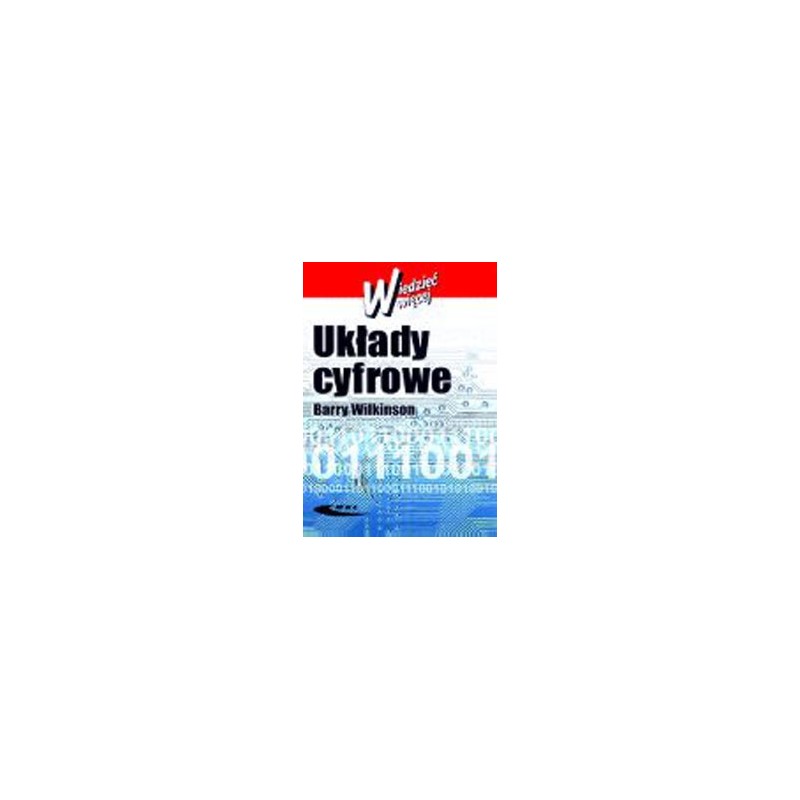


zł43.00 tax excl.
Barry Wilkinson
| Author: Barry Wilkinson ISBN: 83-206-1327-2 Format: B5, 220 pages Publisher: WKiŁ |
| About the book (only in Polish) |
| The book is a concise, practical introduction to the design of digital logic circuits. It can be used by students of all specialties (not only electronics and computer science), students of electronic schools, as well as readers of secondary and higher education interested in the construction and operation of digital circuits. The book describes: basic logic gates, Boolean algebra, design of combinational circuits, flip-flops and counters, design of sequential circuits, programmable logic circuits, testing of logic circuits. Table of Contents: Preface Digital systems and information storage 1.1 Area of applications of digital systems 1.2. Representation of numbers in a digital system 1.2.1 Binary numbers 1.2.2 Number conversion 1.2.3 Hexadecimal and octal numbers 1.3 Basic arithmetic operations on binary numbers 1.3.1 Addition 1.3.2 Negative numbers and subtraction 1.3.3 Decimal numbers coded in binary 1.4. Representation of alphanumeric symbols 1.5 Example of a digital circuit 1.6 Summary 1.7 Tasks 1.8. Supplementary literature Logic gates 2.1 Logic signals 2.2 Basic logic functions 2.2.1. NOT gate 2.2.2 AND gate 2.2.3 OR gate 2.3 Boolean expressions 2.3.1 Identities and their use 2.3.2. Basic laws of algebra 2.3.3 Dualism 2.3.4 DeMorgan's law 2.4 Universal gates 2.4.1. NAND Gateway 2.4.2. NOR gate 2.5 Other types of goals 2.5.1. Exclusive gate-OR 2.5.2. Exclusive gate-NOR 2.5.3 Alternating functions 2.6 Construction of gates 2.6.1. Combination TTL logic circuits 2.6.2 MOS gateways 2.7 Summary 2.8 Tasks 2.9. Additional literature Designing combinational circuits 3.1 Combination systems 3.2. Implementation of Boolean expressions 3.2.1. Summation expressions 3.2.2. Product expressions 3.3 Alternative implementations 3.4 Simplifying logic circuits 3.4.1 Algebraic simplification of logical expressions 3.4.2 Karnaugh minimization method 3.5 Combined MSI logic circuits 3.5.1 Decoders and demultiplexers 3.5.2 Multiplexers 3.5.3 Arithmetic systems 3.6 Summary 3.7 Tasks 3.8. Additional literature Flip-flops and counters 4.1. Sequential systems 4.2 Memory systems built from gates 4.3 Flip-flops 4.3.1 SR selector 4.3.2 Type D latch 4.3.3 JK trigger 4.4 Registers 4.4.1 Shift registers 4.4.2. Applications of registers 4.5 Counters 4.5.1 Counters with JK triggers 4.5.2 Counters with D type latches 4.5.3. Conditions for the initialisation of digital systems 4.5.4 Binary counter back 4.5.5 Serial binary counters 4.6 Summary 4.7 Tasks 4.8. Additional literature Designing sequential circuits 5.1. Model of a synchronous sequential circuit 5.2. Designing synchronous sequential circuits 5.2.1 Design example 1-numerator with any code and two state sequences 5.2.2 Design example 2 - the sequence detector 5.2.3. Use of JK trigger devices 5.2.4. Arrangements according to the Mealy model 5.2.5 Minimizing states 5.2.6 Graphs of transitions with Boolean expressions describing the terms of the acquisition 5.2.7. Systems not fully defined 5.2.8. Code coding "lzn" 5.3 Summary 5.4 Tasks 5.5. Additional literature Designing using programmable systems 6.1 Programmable logic circuits (PLD) 6.2 Combination PLD systems 6.2.1 Programmable logic matrices (PLA) 6.2.2 Programmable matrix logic circuits (PAL) 6.3. Sequential PLD systems 6.3.1 PLD register systems 6.3.2 Macrocells 6.4 Software tools for system synthesis in PLD structures 6.4.1 Structure of the source description in the ABEL language 6.4.2 Combination functions 6.4.3 Sequential functions 6.5. Use of read-only memory (ROM) 6.6 Summary 6.7 Tasks 6.8. Supplementary literature Testing logic circuits 7.1 Need for testing 7.2 Damage and error models 7.3. Generation of test vectors for combinational circuits 7.3.1. Array and algebraic methods 7.3.2 Method of stimulating the path 7.4 Testing sequential circuits and complex systems 7.4.1 Test path method 7.4.2 Built-in self-testing 7.4.3 Edge testing 7.5 Summary 7.6 Tasks 7.7. Supplementary literature Answers to exercises Index of things |
No product available!
Duncan Dowson, M. Priest, G. Dalmaz, A Lubrecht
No product available!
Robert Nowak, Andrzej Pajak
Włodzimierz Solnik, Zbigniew Zajda
Krystyna Maria Noga, Marcin Radwański
Marcin Chruściel
Tomasz Jabłoński
Maciej Szumski
Andrzej Chrzęszczyk
Marcin. Bonds

Barry Wilkinson
